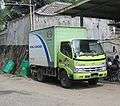Hino Dutro
| Hino Dutro & Hino 300 Series | |
|---|---|
|
| |
| Overview | |
| Manufacturer |
Hino Motors, Ltd. Kuozui Motors Toyota Motor Corporation |
| Also called |
Toyota Dyna Toyota Toyoace Hino 300 Series Hino Ranger II |
| Production | 1999-present |
| Body and chassis | |
| Class | Truck |
| Body style | Truck (standard cab, crew cab) |
| Powertrain | |
| Transmission |
5-speed manual 6-speed manual 4-speed automatic 6-speed automatic |
| Chronology | |
| Predecessor | Hino Ranger 2/3 |
The Hino Dutro (Japanese: 日野デュトロ) is a light commercial truck shared with the Toyota Dyna, manufactured by Hino Motors. Like the Dyna and its twin Toyoace, the Dutro is built on the U300 platform for standard cab, or U400 platform for the wide cab and offered in many different chassis type suitable for different purposes. The Dutro took over from the earlier Ranger 2 (and Ranger 3), a badge-engineered version of Daihatsu's Delta series. Outside of Japan, it is also known as the '300 series'.
For export market, the Dutro is sold in Australia, Chile,[1] Colombia, Indonesia, Malaysia, the Philippines, Thailand, Sri Lanka and other countries in Latin America. As of 2008, the Dutro was available in Canada as the 'Hino 155'. Canadian models are built in Woodstock, Ontario from CKD kits imported from Japan.
The Andinian and Latin-American models are built in Cota (Cundinamarca), Colombia and in Chile, from CKD kits imported from Japan. In some of these markets, however, the trucks are imported from Japan completely assembled.
Manufacturing
Japan
- A wide range of variants is offered in Japan, including the Wide Cab, Double Cab, hybrid electric, 4WD, and Route Van. Engine choices include the 3.7 liter 4B, 4.1 liter 15B-FTE, 4.0 liter N04C, 4.6 liter S05C, 4.7 liter J05D, 4.8 liter S05D, and 5.3 liter J05C.
Indonesia
- Introduced in Indonesia in 2002 with five models: 125ST, 125LT, 125HT, 140GT, and 140HT. All are Standard Cab. 125ST is 4-wheel short wheelbase, the rest are 6-wheel long wheelbase. Engine for 125 models is 4.0 liter W04D, the 140 models is powered by 4.6 liter S05C.
- Starting from 2007 model year, with the government requirement that all vehicles must comply to Euro-2 emission regulation, and Hino introduced 4 models with the modified W04D engine with inter-cooled turbocharger. The new models are 110SD, 110LD, 130MD, and 130HD.
Thailand
- In Thailand: Dutro 300, 301, 340 (Standard Cab), 410 and 420 (Wide Cab).
Colombia
A new assembly plant is located in the town of Cota, in Colombia, built and financed by two partners: one local company and the Toyota group, the majority owner of the Hino subsidiary and the brand.[2][3] The initial products of this portfolio, assembled at this factory and related with this article are:
- Hino Series 300 Light cargo:
- Dutro series Trucks.
Second Generation (2011-present)
Many of these are built in Japanese plants, although some units are assembled in Canada, Colombia[2] and Indonesia. The more appreciable changes are the engine (accomplishment with the EURO IV/V/VI standard), a new facelift made by Toyota, and more and new improved equipment on board.
Gallery
 Dutro 125ST WU300 Box in Indonesia
Dutro 125ST WU300 Box in Indonesia Dutro 125LT WU340 Flat Bed in Indonesia
Dutro 125LT WU340 Flat Bed in Indonesia- Dutro Hybrid
- Dutro Route Van
 Dutro 130MD-L
Dutro 130MD-L Dutro (2nd generation) live fish transporter
Dutro (2nd generation) live fish transporter.jpg) Standard cab equipped PCS rader since 2016 model(Forward)
Standard cab equipped PCS rader since 2016 model(Forward)
References
- ↑ "Hino, Calidad que da confianza". Hino.cl. Retrieved 2012-03-14.
- 1 2 "HMMC Inaugura su planta en Cota, Colombia". Pracodidacol.com. Retrieved 2012-03-14.
- ↑ "La planta de Hino Motors en Colombia llegó a la unidad mil - Industria automotriz: Fabricación, tendencias y avances en vehiculos - ELTIEMPO.COM". Motor.com.co. Retrieved 2012-03-14.
External links
 Media related to HINO Dutro at Wikimedia Commons
Media related to HINO Dutro at Wikimedia Commons- (in Japanese) Hino Dutro